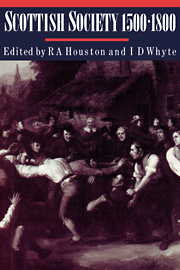Book contents
- Frontmatter
- Contents
- List of tables
- Notes on contributors
- List of abbreviations
- Introduction: Scottish society in perspective
- 1 Population mobility in early modern Scotland
- 2 Scottish food and Scottish history, 1500–1800
- 3 Continuity and change in urban society, 1500–1700
- 4 Women in the economy and society of Scotland, 1500–1800
- 5 Social responses to agrarian ‘improvement’: the Highland and Lowland clearances in Scotland
- 6 ‘Pretense of blude’ and ‘place of thair dwelling’: the nature of highland clans, 1500–1745
- 7 North and south: the development of the gulf in Poor Law practice
- 8 Scotland and Ireland, 1600–1800: their role in the evolution of British society
- 9 Kindred adjoining kingdoms: an English perspective on the social and economic history of early modern Scotland
- Bibliography of printed sources and secondary works
- Index
8 - Scotland and Ireland, 1600–1800: their role in the evolution of British society
Published online by Cambridge University Press: 08 March 2010
- Frontmatter
- Contents
- List of tables
- Notes on contributors
- List of abbreviations
- Introduction: Scottish society in perspective
- 1 Population mobility in early modern Scotland
- 2 Scottish food and Scottish history, 1500–1800
- 3 Continuity and change in urban society, 1500–1700
- 4 Women in the economy and society of Scotland, 1500–1800
- 5 Social responses to agrarian ‘improvement’: the Highland and Lowland clearances in Scotland
- 6 ‘Pretense of blude’ and ‘place of thair dwelling’: the nature of highland clans, 1500–1745
- 7 North and south: the development of the gulf in Poor Law practice
- 8 Scotland and Ireland, 1600–1800: their role in the evolution of British society
- 9 Kindred adjoining kingdoms: an English perspective on the social and economic history of early modern Scotland
- Bibliography of printed sources and secondary works
- Index
Summary
Ireland and Scotland are two of the four countries that make up the British Isles. They represent over time interesting parallels and contrasts. They also both experienced over time a growing degree of integration into the larger political and economic entity that revolved around London and its imperial interests. For both countries, small and lacking in a wide range of opportunity for the ambitious, London and empire provided a stimulus that powerfully affected their development. Centralisation of power and wealth in London and the rapid economic development of both Scotland and Ireland in the eighteenth century are closely related phenomena. Peripheral resources in manpower and capital helped to reinforce the centralised power of London, and at the same time the opportunity and mobility that London and the empire created powerfully influenced Irish and Scottish society in many ways.
Scotland was the more geographically mobile of the two societies and imperial outlets were greatly to enhance that mobility. The contrast in mobility even at the outset meant that Scotland and Ireland were already different societies in 1600. Close links had long existed of course between the north of Ireland and the Highlands. Indeed, as Scotland was seen more by outside visitors who travelled through the Lowlands but did not cross the Highland line, the similarity between much of Irish and Scots society can be overlooked. However, Lowlanders were predominant in contacts with Ireland in the seventeenth century, and contact with the Highlands recedes to a few patchy ties in trade in the eighteenth century.
- Type
- Chapter
- Information
- Scottish Society, 1500–1800 , pp. 226 - 244Publisher: Cambridge University PressPrint publication year: 1989
- 3
- Cited by



